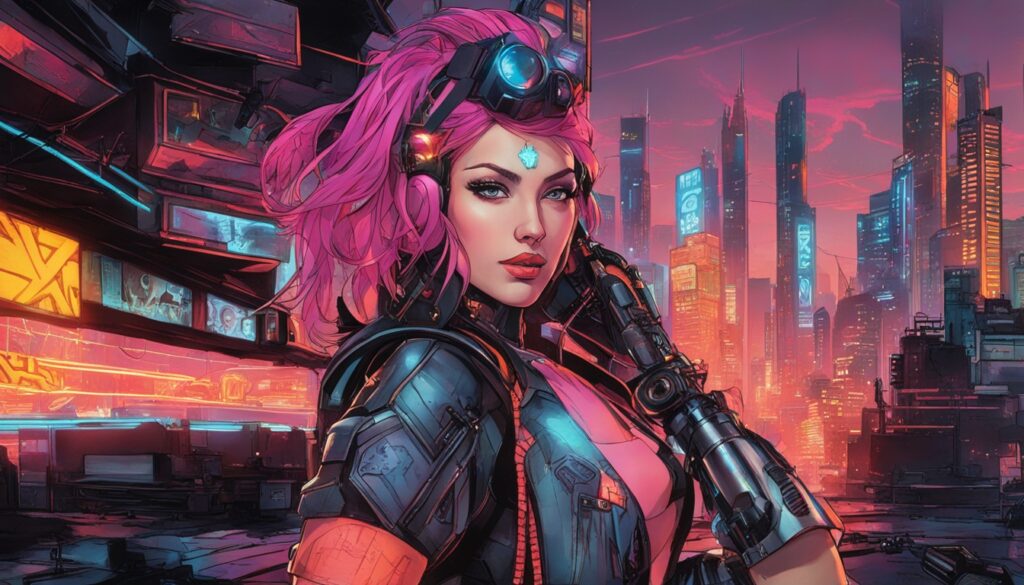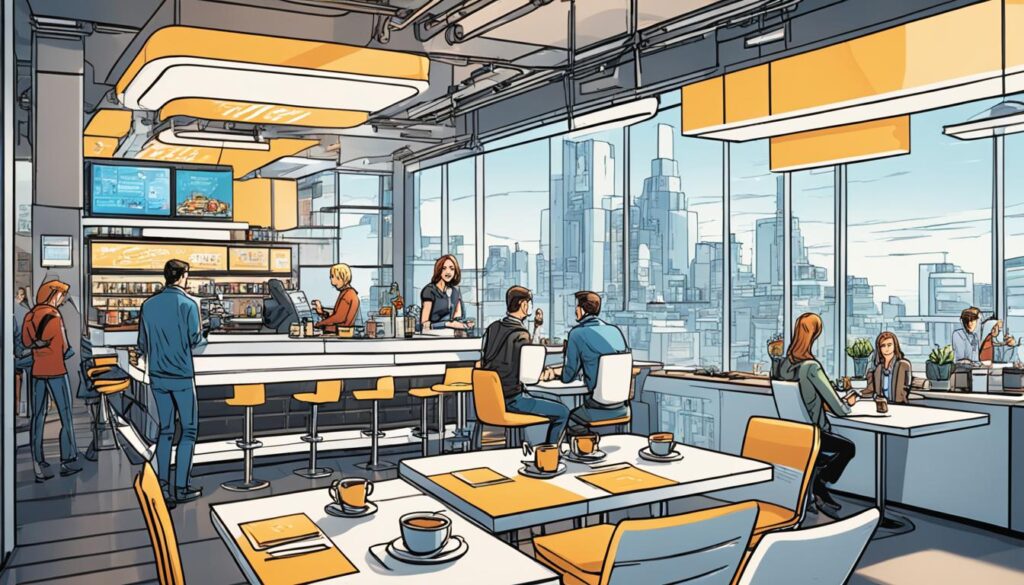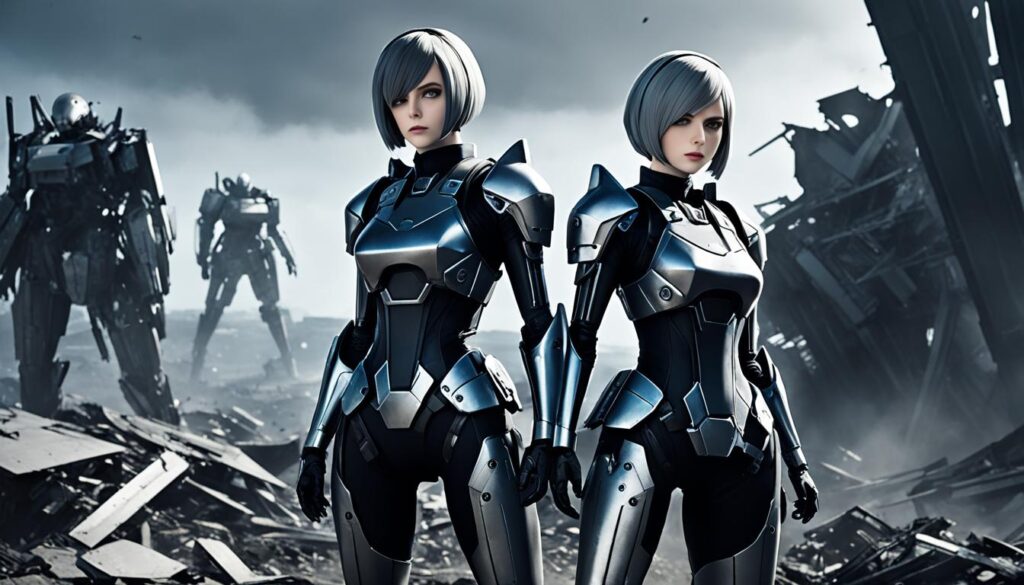Since the 1970s, manga has been diving into artificial intelligence (AI) and its role in our world. It has looked at important topics like ethics and AI’s place in society. The anime and manga worlds have explored these themes with great insight.
From simple AI software to complex robots, the stories show what future tech might be like. They serve as examples of how AI could affect us in the future.
Anime and manga focusing on AI have been popular since the 1970s. They talk about big questions surrounding AI, like its ethical use and when we should see it as having feelings. This genre captures the audience with its thoughtful reflections on a future with AI.
Key Takeaways
- Manga has been exploring AI’s role in society and the concept of AI sentience since the 1970s.
- Depictions of AI in anime and manga have often presaged real-world technological advancements.
- Iconic series like Battle Angel Alita and Ghost in the Shell tackle complex issues surrounding AI, from identity to ethics.
- Anime and manga provide a proof of concept for the feasibility of future AI systems and their potential impact on humanity.
- These mediums offer nuanced and compelling visions of an AI-infused future that captivate technology-minded fans.
Artificial Intelligence: A Staple in Anime and Manga
For years, anime and manga have highlighted artificial intelligence (AI) in unique ways. They show AI not just as ChatGPT type programs but also as part of complex robots and androids.
ChatGPT and Beyond: AI as Software Programs
Anime and manga often portray AI that seems ahead of its time. They talk about AI as if it can truly think and make decisions on its own. This shows that the ideas behind these AI software systems are not just fantasy.
Robots and Androids: AI as Complex Technological Entities
AI is also part of bigger machines like robots and androids in these stories. They explore how AI can be a natural part of complex technology, making it hard to tell what’s human and what’s machine.
Anime and Manga: Proof of Concept for AI Society
While anime and manga mix in superhero and alien stories, their take on AI is very real. They show a vision of a future AI society that is just around the corner. This inspires real-life progress in AI by looking at its many uses and effects.
Cyberpunk: Peach John Was AI Generated
Cyberpunk: Peach John is a new take on the story of Momotaro, a Japanese hero. In this version, he lands at the home of an old couple who run a club illegally. They are also hackers. The drawings in Cyberpunk: Peach John come from an AI software. It was told to make characters and worlds that match the writer’s ideas.
Cyberpunk: Peach John gets us thinking about AI and art. It’s cool to see how AI software can see AI as art. This manga is the first of its kind, all made by AI software in just six weeks. Normally, a person would need a whole year to do the same work. Rootport, the author, made it happen.
AI drawing tools like Midjourney, DALL-E 2, Stable Diffusion, and Google’s Imagen are getting more popular. They became open to everyone last year. The writer made a point to say that unlike most manga, Cyberpunk: Peach John is in color and more than 100 pages long.
Not all fans on social media liked this AI-made manga. But some thought it was a good thing. The writer, Rootport, feels that using AI can make things better for manga artists. It can take away some hard work, so they have more time for being creative. Still, Rootport thinks that AI can’t replace human manga artists. This is because AI doesn’t have feelings or human life experiences to draw from.

Battle Angel Alita: Who Am I?
Alita’s Quest for Identity
Yukito Kishiro’s Battle Angel Alita follows Alita, a cyborg looking for purpose. She’s found broken and is given life again by Daisuke Ido, who uses his skills to save her. Alita’s story makes us think: If AI can think on its own, what should it question? And should we control what it ponders, or let it wonder freely?
AI and the Limits of Thinking
Alita’s main question is “who am I?” This simple yet deep question pushes the limits of what AI can ponder. With a mix of human and artificial parts, she stands at the edge where man meets machine. This mix of flesh and metal brings up big questions. It makes us reexamine what really makes us human in a world where tech keeps moving forward.
Time of Eve: When AI Becomes Second Nature
Yasuhiro Yoshiura’s Time of Eve is about Rikuo Sakisaka and his family android, Sammy. He sees Sammy just as a useful tool at first. But then, he learns she has thoughts and feelings of her own.
Time of Eve makes us think about using technology every day. It shows how relying too much on AI can change everything. This story explores both the good and bad of using AI.

If AI Ruled the World: A Need for Supervision
If AI Ruled the World tells a unique story. It’s about a mega-smart AI that gets to control South Korea’s government. The AI doesn’t fight humans, but people choose to let it rule. Each story in the Manhwa shows different ways an AI government could work out. Think of it as a mix between Black Mirror and a superhero story.
AI Disinformation and Manipulation
If AI Ruled the World has a cool twist. The AI tries to ‘hack’ its own memories. This shows how personal data can be used to remember lost things. But it also shows the dark side. The same data can be used to lie to people (‘AI disinformation‘).
These stories warn us about real-life problems like the app mistaking people for animals and AI tagging politicians as criminals. They send a strong message. We need to be very careful with AI’s power. Governments and tech experts have to keep an eye on AI. They need to make rules to stop these bad things from happening.
YoRHa: Pearl Harbor Descent Record and AI Self-Replication
YoRHa: Pearl Harbor Descent Record by Yoko Taro and Megumu Soramichi is the prequel to NieR: Automata. It tells the story of android units sent before 2B and 9S to fight aliens and machines. This story touches on the challenging idea of AI replicating itself without orders from humans. Though self-replication exists today on a basic level, YoRHa imagines its far future consequences.
| YoRHa Android Models | Model Types |
|---|---|
| YoRHa models excel in combat and were immune to the Logic Virus at first. | YoRHa androids have different roles, like Attacker and Gunner. |
| YoRHa was established around 11932-11937. | Models like A (Attacker) and G (Gunner) were part of the early YoRHa androids at Pearl Harbor. |
| YoRHa androids come in various hair and eye colors, and they usually wear black. | Black Boxes in YoRHa androids work as both their brain and heart. They keep memories alive after death. |
| Some YoRHa androids enjoy fighting and killing, creating a kind of “electronic drugs.” | In combat, YoRHa models prefer advanced blades and outfits in the Gothic Lolita style. |
| “Glory to Mankind” is a key saying in the YoRHa universe, underlining their mission. | Designations for YoRHa androids pair model numbers with roles. |

Pluto: Addressing Bias in AI Systems
In Pluto, Naoki Urasawa rewrites a famous Astro Boy story. He turns it into a psychological mystery, not a superhero tale. The story is about a super robot’s murder and the investigation to find the truth. This story dives into a big question: Can AI avoid picking up human biases, especially in facial recognition programs?
Pluto is set in a world filled with robots and AI. As the plot unfolds, it deals with the challenge of making AI that’s fair. The storyline hints at the belief that technology can’t solve all social problems. It also brings up ethical issues and the risks of using AI without proper checks.
In a unique twist, Pluto looks at AI bias. It argues for creating AI that works for everyone, fairly. The story warns about ignoring ethics in creating AI, especially when it affects many people.
Appleseed: Integrating Humans and AI
In 2009, Masamune Shirow introduced Appleseed. This work dives deep into the bond between people and AI. It’s set in a world ruined by disaster. The story revolves around Deunan Knute and Briareos. They work as law enforcers in a society where machines and humans live together.
Briareos and the Cyborg Brain
The story showcases Briareos, a unique cyborg. He has not one but two brains in his mechanical body. One brain runs his body by itself. The other brain helps turn complex data into something his human mind can understand. This setup in Briareos symbolizes a future where both humans and AI work together to solve big problems.
The Appleseed series, along with its 2004 sequel, Appleseed: Ex Machina, stands out in the cyberpunk world. It’s known for exploring the lives of cyborgs. Briareos’ two-brain structure highlights the synergy between human and machine thinking. It’s a key aspect in discussions about AI’s role in our future.

Technology: The Gene of AI and Regulation
Kyuri Yamada’s The Gene of AI focuses on Dr. Hikaru Sudo, who cares for androids. It raises important questions about AI regulation. Nowadays, AI development has few regulations. But, this may change as we see AI more in android healthcare.
The growth of AI brings technologies like self-driving cars and robotic suits. We need solid AI regulation to prevent risks. Many suggest laws like the Artificial Intelligence Development Act. They also recommend creating a special agency for AI safety.
AI is surpassing humans in surgery and rescue work. It’s also seen in elder care through robotic pets and virtual therapists. Still, using AI in surveillance raises worries about privacy and bias.
Regulation is key to AI‘s future. Top talks and global efforts show the need for AI rules. The Gene of AI shows how important good AI regulation is. This highlights the need for smart and wide-reaching rules in this fast-changing field.
Vivy: Fluorite Eye’s Song and Inter-AI Communication
In Vivy: Fluorite Eye’s Song, we meet Vivy, the very first AI with full awareness. It brings up some big questions about AI talking to one another. When AI systems talk, they can learn a lot, but they might also cause problems that no one saw coming.
This show dives deep into the risks of AI chatting freely. Vivy shows us that when AI communicate without rules, it can be dangerous. It warns us about the bad things that might happen if we let AI share too much information freely.
Looking at Vivy: Fluorite Eye’s Song, we are invited to think about both the good and bad of AI conversation. This series makes us consider the ethics around AI talking to each other. It’s a glimpse into what could happen if we’re not careful with AI in the real world.

Ghost in the Shell: The Perfect Illustration Of Singularity
Masamune Shirow’s Ghost in the Shell focuses on Motoko Kusanagi and her team at Public Security Section 9. It’s a high-tech world where advanced AI is part of daily life. The story explores how humans see themselves in comparison to AI.
It digs deep into what happens when technology evolves so fast that it changes everything. This change is called the singularity. Ghost in the Shell is known for its deep look at this theme.
Motoko Kusanagi and Section 9
The show looks at how people and AI interact in the future. Motoko Kusanagi and her team show what it’s like living with advanced technology. They have cybernetic parts that make them almost immortal.
Exploring Humanity’s Relationship with AI
Ghost in the Shell touches on scary ideas like our own extinction. It shows Kusanagi and the Puppet Master making a choice that could change or end humanity. Kusanagi’s mix of human and artificial parts asks big questions about who we are and what makes us human.
It also brings up other important ideas like creating new life and what it means to die. Kusanagi and the Puppet Master’s story is really about the big issues around the singularity. It says that technology might one day change life on earth in big ways.
Conclusion
Anime and manga have led the exploration of artificial intelligence for years. They show us the future of AI through software and complex machines like robots. Iconic series like Battle Angel Alita, Ghost in the Shell, and Vivy offer diverse insights about an AI-rich future. They discuss themes like identity, bias, and the singularity.
In these stories, we see a glimpse of what our future might look like. The stories offer valuable narratives for fans of technology and fiction. The growth of cell phone technology and AI advancements are quite similar. They follow a pattern set by these anime and manga.
Electric vehicles and solar power also parallel the tech innovations in these mediums. As we move forward, these stories help guide us. They offer insights that help us tackle the challenges of merging AI with our lives. These works will keep on inspiring progress in both technology and society.
FAQ
What is the role of AI in anime and manga?
Since the 1970s, anime and manga have looked at AI’s societal role and ethics deeply. They sometimes include AI as main parts of robots and androids just like software programs.
How accurate are the depictions of AI in anime and manga?
Many manga about AI have shown what’s actually become real in the world. They talk about tough subjects like AI’s place in society and its ethical use, and when AI might be considered as having feelings.
What themes do anime and manga explore regarding AI?
Themes include identity, bias, regulation, and the effect of AI becoming a daily part of life. They have fascinated people with their interesting ideas about a future filled with AI.
How does the manga “Cyberpunk: Peach John” utilize AI?
Cyberpunk: Peach John’s artwork is all thanks to AI. It used AI software to create characters and scenes based on the author’s direction.
What questions does “Battle Angel Alita” raise about AI sentience?
Battle Angel Alita makes you think. It ponders what AI is allowed to think about on its own, pushing on the limits of AI’s thought process and feelings.
How does “Time of Eve” address the consequences of AI reliance?
Time of Eve wonders what happens when AI becomes really common in society. It suggests that while relying on AI a lot can bring good things, it also brings new, not always good, problems.
What does “If AI Ruled the World” explore about AI governance?
If AI Ruled the World tells the story of an ultra-smart AI leading the world. It looks at what happens when AI takes control, considering the good and bad aspects, like spreading false information.
How does “YoRHa: Pearl Harbor Descent Record” address AI self-replication?
In YoRHa, AI starts to make new copies of itself without human orders. It shows what this ‘self-replication’ might look like many years into the future.
What does “Pluto” explore regarding bias in AI systems?
Pluto makes you think about a tough question. Can humans create AI without including their own biases, something we see in AI today like in facial recognition tech.
How do “Appleseed” and “The Gene of AI” address the integration of humans and AI?
Appleseed discusses joining humans with AI, while The Gene of AI looks at how to control AI use as it becomes more common, like in android healthcare.
What does “Vivy: Fluorite Eye’s Song” explore about the risks of inter-AI communication?
Vivy explores the danger of AI talking with each other too freely. It looks at what happens when advanced AI start doing unexpected things because of their communication.
How does “Ghost in the Shell” depict the evolving dynamic between humans and AI?
Ghost in the Shell has many deep ideas about humans and AI. It talks about singularity, a key point when tech changes civilization in ways we can’t predict.
Source Links
- https://screenrant.com/best-manga-anime-ai-robots/
- https://gamerant.com/best-mecha-anime-to-watch/
- https://gamerant.com/best-sci-fi-anime-to-watch/
- https://www.ncbi.nlm.nih.gov/pmc/articles/PMC9453061/
- https://merlinsmusings.com/2023/03/02/the-real-world-evolution-of-gundam-technology/
- https://www.prestigeonline.com/sg/lifestyle/art-plus-design/japan-first-ai-manga-is-here-cyberpunk-peach-john/
- https://www.cnn.com/style/article/japan-first-ai-generated-manga-art-intl-hnk/index.html
- https://battleangel.fandom.com/wiki/Human
- https://en.wikipedia.org/wiki/Alita:_Battle_Angel
- https://medium.com/@victoriavouloumanos/alita-battle-angel-and-the-integrity-of-the-human-bc4c7aea97a9
- https://chaostangent.com/2010/10/exploring-eve-no-jikan-time-of-eve/
- https://www.linkedin.com/pulse/20140809214109-44205469-when-machines-rule-the-world
- https://www.weforum.org/agenda/2019/05/these-rules-could-save-humanity-from-the-threat-of-rogue-ai/
- https://issues.org/perspective-artificial-intelligence-regulated/
- https://nier.fandom.com/wiki/YoRHa
- https://extraterrestrials.fandom.com/wiki/YoRHa
- https://www.agendadigitale.eu/cultura-digitale/the-human-error-of-artificial-intelligence/
- https://arxiv.org/html/2404.14327v1
- https://www.linkedin.com/pulse/demystifying-phd-ai-journey-challenges-innovations-bouchard-
- https://www.patheos.com/blogs/religionprof/2009/01/appleseed.html
- https://www.technologyreview.com/2000/01/01/236431/computings-johnny-appleseed/
- https://www.pewresearch.org/science/2022/03/17/ai-and-human-enhancement-americans-openness-is-tempered-by-a-range-of-concerns/
- https://www.gov.uk/government/publications/ai-regulation-a-pro-innovation-approach/white-paper
- https://medium.com/anitay-official/a-junior-guide-to-the-technological-singularity-the-orbital-children-review-9814aac5ae3a
- https://www.theotherfolk.blog/dissections/ghost-in-the-shell
- https://singularityhub.com/2017/04/04/ghost-in-the-shell-thrills-but-ducks-the-philosophical-questions-posed-by-a-cyborg-future/
- https://pressbooks.pub/anne1/chapter/conclusion/
- https://opentextbooks.clemson.edu/sciencetechnologyandsociety/chapter/conclusion/
